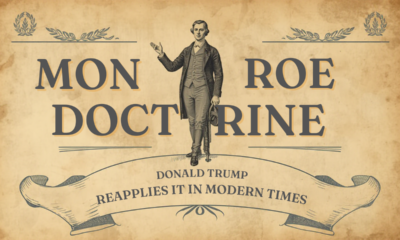Executive
Del Toro Missed the Boat on SLCM-N and on the Submarine Force’s Role

For several months Navy Secretary Carlos Del Toro has been waging an overt and covert campaign against SLCM-N. His public testimony makes clear that he not only misunderstands the role of a nuclear sea-launched cruise missile in national policy but also the role of the submarine force.
Del Toro sharing misinformation
In a clearly scripted colloquy with Senator Mark Kelly on May 16, Del Toro asserted that deploying SLCM-N on SSNs would adversely impact the submarine force: “I’m concerned about how it will operationally impact our submarine forces and their ability to actually conduct the tactics and operations that they actually need to do in the south, in the Indo-Pacific and elsewhere around the world”; said it would “fundamentally change the mission of the submarines themselves”; agreed with Senator Kelly that the system was unnecessary because the Trident II W-76-2 warhead was sufficient for deterrence purposes; and also agreed with Kelly that the removal of conventional torpedoes to accommodate SLCM-N would reduce SSNs’ wartime utility. There’s a great deal of misinformation in all that. Let’s unpack it piece by piece.
Submarines exist to deter war
First, the primary mission of the submarine force (indeed of all of our armed forces) is to deter major war. If deterrence fails, our forces are to fight and win – but deterrence is the first mission. In an increasingly dangerous world in which our two peer adversaries deploy large numbers of theater nuclear systems, a U.S. nuclear sea-launched cruise missile would enhance deterrence and reassure allies in peacetime and crisis, and, in wartime, provide a President with additional options to prevent enemy nuclear escalation. The W 76-2 is an excellent weapon, but any President deserves more than one option; the combination of the ballistic W 76-2 and the airbreathing SLCM-N would provide a President with significant flexibility to manage a crisis.
Given the large Russian and Chinese deployments of theater-oriented nuclear systems, the consensus report of the recently concluded Congressionally mandated bipartisan Strategic Posture Commission recommended that the U.S. develop and deploy theater nuclear delivery systems that are forward deployed, survivable and timely. While the Commission did not name a specific system, it is clear SLCM-N meets all these criteria.
Fast-attack boats do more than sink enemy ships
Second, Del Toro and Sen Kelly suggest that sinking enemy ships is the only mission for the SSN force. Anyone familiar with submarines knows that that is palpably false. SSNs are tasked with intelligence gathering, supporting Special Warfare Teams, and power projection/land attack in addition to sinking enemy surface and sub-surface combatants. (Indeed some-old school naval purists suggested decades ago that adding conventional Tomahawks to the SSN mission set detracted from “their real mission”, but the ensuing years have proven how well sub-launched TLAM’s have served the nation.)
Third, the hidden secret underlying this issue is that the non-SSBN Navy does not want nuclear weapons aboard its ships. This was not always the case. Throughout the Cold War U.S. carriers deployed with nuclear gravity bombs and ASW weapons; surface combatants carried a range of nuclear-tipped anti-air and ASW weapons; and SSNs carried nuclear-tipped torpedoes and the SUBROC ASW systems. From the 1980s until the end of the Cold War surface ships and SSNs also carried nuclear tomahawks (and those nuclear Tomahawks contributed significantly to deterring Soviet nuclear attacks on our aircraft carriers).
Unjustifiable prejudice against having nukes aboard any ship other than a “boomer”
Indeed, as a junior officer I served for three years on a ship with nuclear weapons. For half that period I served as the Communications Officer, responsible, among other duties, for the proper handling, training, and exercising of the two-man control nuclear communications material; for the other half of my tour, I “owned” two nuclear-tipped anti-submarine rockets as the ship’s ASW officer. The additional security, personnel vetting, and command and control associated with all the Navy’s nuclear systems was part of everyday life at sea and was eminently manageable – as thousands of Cold War Navy veterans will attest.
Once the non-SSBN Navy was “denuclearized” by President George H.W. Bush, a decision which made sense given the geo-political conditions and predictions at the time, preventing the return of nuclear weapons to the fleet became an obsession for some. When President Clinton removed the last deployed nuclear system, the TLAM-N from SSNs, he directed the Navy to make plans to redeploy it if necessary. The Navy’s “redeployment plan” was farcical, deliberately designed in manner so that it could not be implemented. In parallel, the Navy deliberately delayed developing a fire control system to allow the analog TLAM-N to be fired from digital Virginia boats for over a decade (until President Obama’s retirement of that system made the issue moot). While Secretary Del Toro apparently still subscribes to this prejudice, it is wrong and needs to be addressed head-on and eliminated.
Del Toro ignores best military advice
Finally, there is the question of “best military advice”. Numerous combatant commanders have called for deploying SLCM-N. The Chief of Naval Operations, Adm. Lisa Franchetti, has told the Senate on multiple occasions: “SLCM-N is a tailored option the President should have”. The Secretary should heed the wise counsel of the CNO and the warfighters who have ultimate responsibility for preserving deterrence and winning wars.
The Congress is to be commended for having created and funded the SLCM-N program. The Administration needs to follow the law and proceed as rapidly as possible to develop and deploy the system. And Secretary Del Toro should stop perpetuating and propagating myths about the program and get out of the way.
This article was originally published by RealClearDefense and made available via RealClearWire.
Franklin C. Miller served for three decades as a senior nuclear policy and arms control official in the Pentagon and on the National Security Council staff. He is a principal at the Scowcroft Group.
-

 Executive2 days ago
Executive2 days agoWaste of the Day: Can You Hear Me Now? No.
-

 Civilization2 days ago
Civilization2 days agoTrump’s version of the Monroe Doctrine
-

 Civilization3 days ago
Civilization3 days agoOne Fell Swoop: Lawsuit Eyes Death Blow to Racial Preferences
-

 Civilization2 days ago
Civilization2 days agoTrump’s New Doctrine of Precision Deterrence
-

 Civilization1 day ago
Civilization1 day agoThe Mission to Extradite Nicholas Maduro
-

 Civilization1 day ago
Civilization1 day agoThe Snatch and Grab of Maduro Was Not ‘Illegal’
-

 Executive4 days ago
Executive4 days agoWaste of the Day: $1.6T in Wasteful Spending in Rand Paul’s “Festivus” Report
-

 Guest Columns4 days ago
Guest Columns4 days agoAdvice to Democrats Regarding Maduro Arrest: Resist Reflexive Opposition














